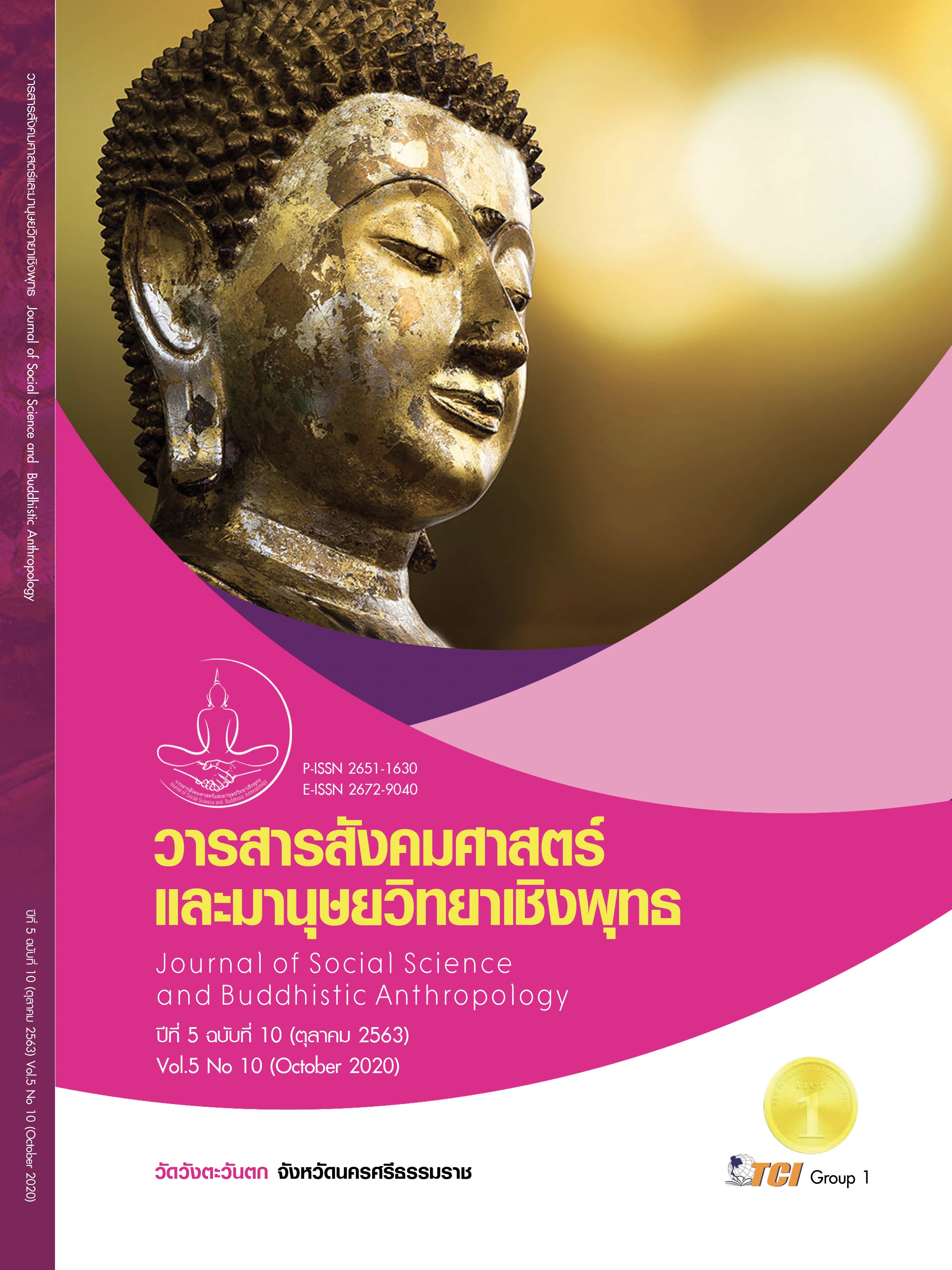FACTORS RELATED TO THE INTENTION TO REPEAT PREGNANCY AMONG PREGNANT ADOLESCENTS
Keywords:
Repeat Pregnancy, Intention to Repeat Pregnancy, Pregnant AdolescentsAbstract
The objectives of this research article were to determine factors related to the intention to repeat pregnancy among adolescents. This is a prospective descriptive study. The sample was 174 multiparous adolescents who attended prenatal care unit at hospital in Health Region 3 during May to December 2019. Data was collected by using questionnaires comprising the demographic data, the attitude towards repeated pregnancy, the subjective norm, the perceived behavior efficacy in preventing repeated pregnancy, and the intention to repeat pregnancy. The content validity of the instruments was examined by five experts. The reliabilities of questionnaires were 0.72, 0.81 and 0.80, respectively. Data was analyzed using descriptive statistics, and the Binary Logistic Regression. Results: Among 38 participants who intend to have repeated pregnant adolescents, the average age was 18.42 years (SD = .91). The average age of those who have the first pregnancy was 16.86 years (SD = .96). Factors found to be related to the intention to repeat pregnancy include the family income (OR = 0.300; 95% CI = 0.147-0.611, financial support source(OR = 8.088; 95%CI = 3.711–17.630), living before pregnancy (OR = 2.406; 95%CI = 1.270-4.561), marital status (OR = 3.446; 95%CI = 1.310-9.016), the intimate person is a teen mother (OR = 0.175; 95%CI = 0.045-0.680), history of contraceptive (OR = 3.15; 95%CI = 1.146-8.660), the attitude towards repeat pregnancy (OR = 0.257; 95%CI=0.063-1.043) and the subjective norm (OR = 0.261; 95%CI = 0.099-0.684) respectively. Pregnant adolescents who had intention to repeat pregnancy mostly were the late adolescence. Those who had low family income, had contraceptive or contraceptive consistency, had a new husband, having a husband as a source of financial support, had positive attitude towards pregnancy, had the subjective norm or believed that their close relatives wanted them to have repeat pregnancy. In accordance with the study findings, professional nurses should realize how the importance of these aforementioned factors and develop a more efficient prevention for repeat pregnancy in teenagers by taking into account these factors.
References
กิตติพงศ์ แซ่เจ็ง และคณะ. (2557). ผลกระทบของการตั้งครรภ์ในวัยรุ่น . นนทบุรี: สำนักอนามัยการเจริญพันธุ์ กรมอนามัย กระทรวงสาธารณสุข.
เกตย์สิรี ศรีวิไล. (2559). การตั้งครรภ์ซ้ำในมารดาวัยรุ่น ในโรงพยาบาลชุมชนแห่งหนึ่งของภาคใต้. วารสารเครือข่ายวิทยาลัยพยาบาลและการสาธารณสุขภาคใต้, 3(3), 142 - 152.
เจนจิรา จิตจง. (2561). สรุปสถานการณ์ ปี 2561 “วัยรุ่น” เขตสุขภาพที่ 3. นครสวรรค์: ศูนย์สุขภาพจิตที่ 3.
ชลทิศ อุไรฤกษ์กุล. (2554). การตั้งครรภ์วัยรุ่น. เรียกใช้เมื่อ 2 มิถุนายน 2554 จาก http://www.hpe4.anamai.moph.go.th.
ธัญพัฒน ฤทธิผล และคณะ. (2562). ทุนชีวิตและปัจจัยที่มีความสัมพันธ์กับการตั้งครรภ์ซ้ำของมารดาวัยรุ่นในจังหวัดอุบลราชธานี. วารสารสาธารณสุขมหาวิทยาลัยบูรพา, 14(2), 78 - 89.
ปฏิญญา เอี่ยมสำอาง. (2555). ปัจจัยเสี่ยงต่อการตั้งครรภ์ที่ไม่ตั้งใจของวัยรุ่น. ใน วิทยานิพนธ์พยาบาลศาสตรมหาบัณฑิต สาขาวิชาการพยาบาลเวชปฏิบัติชุมชน. มหาวิทยาลัยบูรพา.
ปัญญา สนั่นพานิชกุล และยศพล เหลืองโสมนภา. (2558). การตั้งครรภ์ในวัยรุ่น: ปัจจัยทางด้านมารดาที่มีผลต่อทารก. วารสารศูนย์การศึกษาแพทยศาสตร์คลินิก โรงพยาบาลพระปกเกล้า, 32(2), 156 - 174.
มณิสรา ห่วงทอง. (2560). ปัจจัยที่มีความสัมพันธ์กับการตั้งครรภ์ซ้ำอย่างรวดเร็วในหญิงตั้งครรภ์วัยรุ่น. ใน วิทยานิพนธ์พยาบาลศาสตรมหาบัณฑิต สาขาวิชาการผดุงครรภ์ชั้นสูง. มหาวิทยาลัยบูรพา.
ฤดี ปุงบางกะดี่ และเอมพร รตินธร. (2557). ปัจจัยและผลกระทบจากการตั้งครรภ์ซ้ำของสตรีวัยรุ่นไทย:กรณีศึกษาในกรุงเทพมหานคร. วารสารพยาบาลศาสตร์, 32(2), 23 - 31.
วิโรจน์ อารีย์กุล. (2553). การดูแลสุขภาพและการให้คำแนะนำวัยรุ่น. กรุงเทพมหานคร: รุ่งศิลป์การพิมพ์.
แววดาว พิมลธเรศ. (2555). อุบัติการณ์การตั้งครรภ์และภาวะแทรกซ้อนของหญิงตั้งครรภ์วัยรุ่นในโรงพยาบาลหนองใหญ่ จังหวัดชลบุร. วารสารศูนย์การศึกษาแพทยศาสตร์คลินิก โรงพยาบาลพระปกเกล้า, 29(4), 301 - 311.
ศิริพร จิรวัฒน์กุล และคณะ. (2554). รายงานการวิจัย การศึกษาแนวทางการป้องกันและแก้ไขปัญหาการตั้งครรภ์ไม่พร้อมในวัยรุ่น (แม่วัยใส). ขอนแก่น: ศูนย์ประสานงานองค์กรอนามัยโลกด้านการวิจัยและฝึกอบรมด้านเพศภาวะและสุขภาพสตรี มหาวิทยาลัยขอนแก่น.
สำนักอนามัยการเจริญพันธุ์ กรมอนามัย กระทรวงสาธารณสุข. (2560). สถานการณ์อนามัยการเจริญพันธุ์ในวัยรุ่นและเยาวชนปี 2560. เรียกใช้เมื่อ 17 กันยายน 2560 จาก http://rh.anamai.moph.go.th/main.php?filename=index
สำนักอนามัยการเจริญพันธุ์ กรมอนามัย กระทรวงสาธารณสุข. (2562). ยุทธศาสตร์การป้องกันและแก้ไขปัญหาการตั้งครรภ์ในวัยรุ่นระดับชาติ พ.ศ. 2560-2569. เรียกใช้เมื่อ 27 มีนาคม 2562 จาก http://rh.anamai.moph.go.th/main.php?filename=index
สำนักอนามัยการเจริญพันธุ์ กรมอนามัย กระทรวงสาธารณสุข. (2562). สถานการณ์อนามัยการเจริญพันธุ์ในวัยรุ่นและเยาวชนปี 2561. เรียกใช้เมื่อ 27 มีนาคม 2562 จาก http://rh.anamai.moph.go.th/main.php?filename=index
สุภาพร มะรังสี. (2561). ปัจจัยเสี่ยงและแนวทางป้องกันการตั้งครรภ์ซ้ำในวัยรุ่น. วารสารคณะพยาบาลศาสตร์ มหาวิทยาลัยบูรพา, 26(2), 84 - 89.
อรอุมา ทางดี. (2559). การป้องกันและประสบการณ์การตั้งครรภ์ซ้ำในวัยรุ่น จังหวัดนนทบุรี. ใน วิทยานิพนธ์สาธารณสุขศาสตรมหาบัณฑิต สาขาวิชาการผดุงครรภ์ชั้นสูง. มหาวิทยาลัยสุโขทัยธรรมาธิราช.
อังสนา วิศรุตเกษมพงศ์. (2557). ปัจจัยที่มีความสัมพันธ์กับความตั้งใจตั้งครรภ์ซ้ำในหญิงตั้งครรภ์วัยรุ่น. ใน วิทยานิพนธ์พยาบาลศาสตรมหาบัณฑิต สาขาวิชาการผดุงครรภ์ชั้นสูง. มหาวิทยาลัยขอนแก่น.
อังสนา วิศรุตเกษมพงศ์ และสมจิต เมืองพิล. (2558). ปัจจัยที่มีความสัมพันธ์กับความตั้งใจตั้งครรภ์ซ้ำในหญิงตั้งครรภ์วัยรุ่น. วารสารศรีนครินทร์เวชสาร, 30(3), 262-269.
Ajzen, I. (1991). The Theory of Planned Behavior. OBHDP, 50(2), 179 - 211.
Baldwin, M. K. & Edelman, A. B. (2013). The effect of long-acting reversible contraception on rapid repeat pregnancy in adolescents: A review. Journal of Adolescent Health, 52(4), S47 - S53.
Brosens, I. et al. (2017). The Impact of Uterine Immaturity on Obstetrical Syndromes During Adolescence. Am J Obstet Gynecol, 217(5), 546 -555.
Cook, S. M. & Cameron, S. T. (2015). Social issues of teenage pregnancy. Obstetrics. Gynecology and Reproductive Medicine, 25(9), 243 - 248.
Cronbach, L. J. (1951). Coefficient alpha and the internal structure of tests. Psychometrical, 16(3), 297 - 334.
Timur, H. et al. (2016). Factors that affect perinatal outcomes of the second pregnancy of adolescents. Journal of Pediatric and Adolescent Gynecology, 29(1), 18 - 21.








